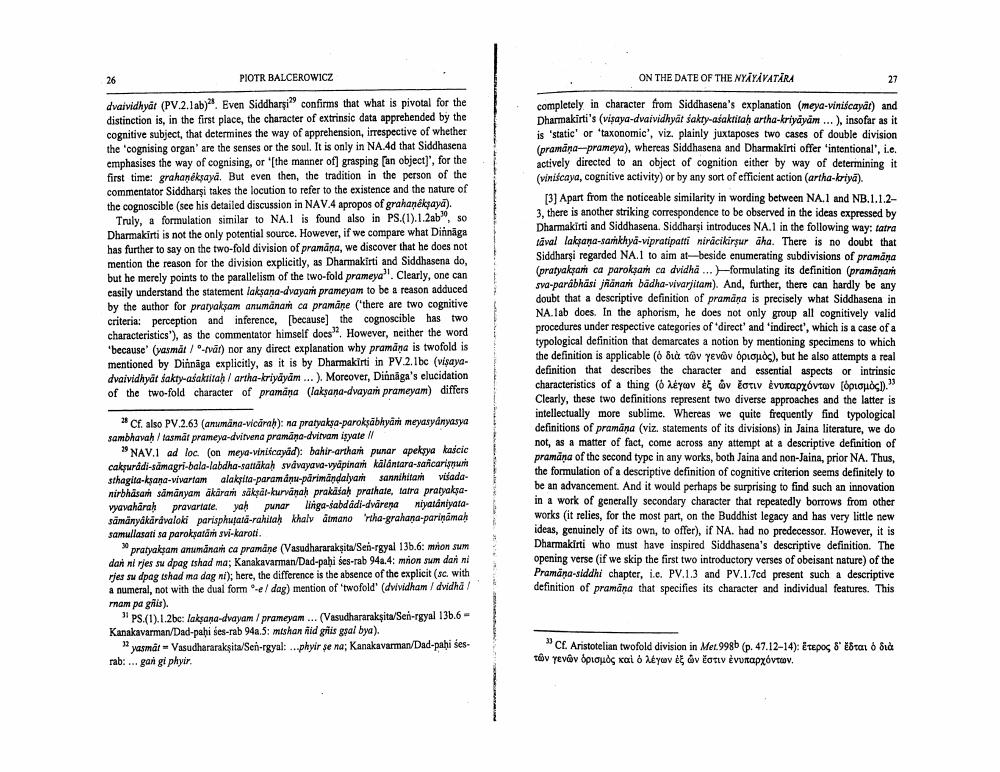Book Title: On The Date Of The Nnyayavatara Author(s): Piotr Balcerowicz Publisher: Piotr Balcerowicz View full book textPage 6
________________ 26 PIOTR BALCEROWICZ ON THE DATE OF THE NYÀYİVATĀRA dvaividhyat (PV.2.1 ab). Even Siddharşi confirms that what is pivotal for the distinction is, in the first place, the character of extrinsic data apprehended by the cognitive subject, that determines the way of apprehension, irrespective of whether the 'cognising organ' are the senses or the soul. It is only in NA.4d that Siddhasena emphasises the way of cognising, or '[the manner of grasping an object)', for the first time: grahanéksaya. But even then, the tradition in the person of the commentator Siddharşi takes the locution to refer to the existence and the nature of the cognoscible (sce his detailed discussion in NAV.4 apropos of grahanê saya). Truly, a formulation similar to NA.1 is found also in PS.(1).1.2ab, so Dharmakirti is not the only potential source. However, if we compare what Dinnaga has further to say on the two-fold division of pramana, we discover that he does not mention the reason for the division explicitly, as Dharmakirti and Siddhasena do. but he merely points to the parallelism of the two-fold prameya". Clearly, one can easily understand the statement laksana-dvayani prameyam to be a reason adduced by the author for praryakşam anumanam ca pramane ('there are two cognitive criteria: perception and inference, [because the cognoscible has two characteristics'), as the commentator himself does". However, neither the word 'because' (vasmát / orvāt) nor any direct explanation why pramana is twofold is mentioned by Dinnāga explicitly, as it is by Dharmakirti in PV.2.1bc (Visaya dvaividhyat fakty-asakritah/ artha-kriyāyām ...). Moreover, Diónāga's elucidation of the two-fold character of pramana (laksana-dvayar prameyam) differs completely in character from Siddhasena's explanation (meya-viniscayat) and Dharmakirti's (visaya-dvaividhyat sakty-asaktitah artha-kriyayam ... ), insofar as it is 'static' or 'taxonomic', viz. plainly juxtaposes two cases of double division (pramana-prameya), whereas Siddhasena and Dharmakirti offer 'intentional'. i.e. actively directed to an object of cognition either by way of determining it (viniscaya, cognitive activity) or by any sort of efficient action (artha-briya). [3] Apart from the noticeable similarity in wording between NA.1 and NB.1.1.2 dence to be observed in the ideas expressed by Dhamakirti and Siddhasena. Siddharşi introduces NA.1 in the following way: tatra taval laksana-samkhya-vipratipatti niracikirşur äha. There is no doubt that Siddharşi regarded NA.1 to aim at-beside enumerating subdivisions of pramana (pratyakşam ca paroksa ca dvidha ... formulating its definition (pramānam sva-parábhäsi jänar bädha-vivarjitam). And, further, there can hardly be any doubt that a descriptive definition of pramana is precisely what Siddhasena in NA.lab does. In the aphorism, he does not only group all cognitively valid procedures under respective categories of direct' and 'indirect', which is a case of a typological definition that demarcates a notion by mentioning specimens to which the definition is applicable (o là tâv yevov OpLOLLOC), but he also attempts a real definition that describes the character and essential aspects or intrinsic characteristics of a thing ( 6ėyv É O ZOTIV europxovtov (Oplopol)." Clearly, these two definitions represent two diverse approaches and the latter is intellectually more sublime. Whereas we quite frequently find typological definitions of pramana (viz. statements of its divisions) in Jaina literature, we do not, as a matter of fact, come across any attempt at a descriptive definition of pramana of the second type in any works, both Jaina and non-Jaina, prior NA. Thus, the formulation of a descriptive definition of cognitive criterion seems definitely to be an advancement. And it would perhaps be surprising to find such an innovation in a work of generally secondary character that repeatedly borrows from other works (it relies, for the most part, on the Buddhist legacy and has very little new ideas, genuinely of its own, to offer), if NA. had no predecessor. However, it is Dharmakirti who must have inspired Siddhasena's descriptive definition. The opening verse (if we skip the first two introductory verses of obeisant nature) of the Pramana-siddhi chapter, i.e. PV.1.3 and PV.1.7cd present such a descriptive definition of pramāna that specifies its character and individual features. This * Cf. also PV.2.63 (arumana-vicārah): na pratyakşa-paroksābhyam meyasyanyasya sambhavah / tasmat prameya-dvitvena pramana-dvitvam isyate Il NAV.1 ad loc. (on meya-viniscayad): bahir-artham punar apeksya kascic caksuradi-samagri-bala-labdha sattákah svávayava-vypinan kälántara-sacarium sthagita-ksana-vivartam alaksita-paramánu-parimandalyan sannihitar visada nirbhåsam sämänyam akararı säkşal-kurvanah prakásah prathale, tatra pratyaksavyavaharah pravartate. yahpunar linga-sabdádi-dvārena niyatántyatasämänyákarávaloki parisphurata-rahitah khaly amano Tritha-grahaņa-parinamah samullasati sa paroksalām svi-karoti. pratyaksam anumanam ca pramane (Vasudhararakṣita/Sen-rgyal 13.6: mion sum dar ni rjes sy dpag Ishad ma; Kanakavarman/Dad-pahi ses-rab 94a.4: mion sum dan ni rjes su dpag ishad ma dag ni); here, the difference is the absence of the explicit (sc. with a numeral, not with the dual formel dag) mention of twofold' (dwvidham/dwidha / mam pa gris). PS.(1).1.2bc: laksana-dvayam/ prameyam ... (Vasudhararakṣita/Sen-rgyal 13.6 - Kanakavarman/Dad-pahi ses-rab 94.5: mtshan nid gris gsal bya). yasmar - Vasudhararakṣita/Sen-rgyal: ...phyir se na; Kanakavarman/Dad-pahi ses. rab:... gangi phyir. CE. Aristotelian twofold division in Met.998b (p. 47.12-14): Etepos 8' stal o la των γενών ορισμός και ο λέγων εξ ών έστιν ενυπαρχόντων.Page Navigation
1 ... 4 5 6 7 8 9 10 11 12 13 14 15 16 17 18 19 20 21
